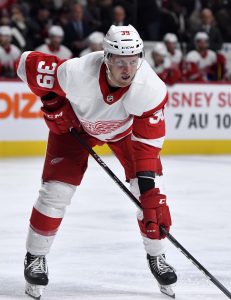In the summer of 2006, the Toronto Maple Leafs decided not to pick up a contract option on 41-year-old Ed Belfour. Totaling three seasons as resident netminder in Toronto, Belfour spent much of his final season in Toronto hampered by a balky back. He was limited to 49 games in 2005-2006 and a substandard .892 save percentage. GM-at-the-time John Ferguson Jr. probably made the right call moving on from Belfour (though Belfour would bounceback somewhat in his one and only season with the Florida Panthers before retiring) – where Ferguson and the Maple Leafs erred was in choosing Belfour’s successor.
Looking ahead, the Maple Leafs had two goalie prospects to dream on: Tuukka Rask and Justin Pogge. Unfortunately, neither Rask, 19, nor Pogge, 20, were ready to step between the pipes. Thus, Ferguson Jr. moved to deal from a position of future depth to secure a near-term solution. Toronto traded Rask to the Boston Bruins in a straight-up swap for 26-year-old goaltender Andrew Raycroft.
On its face, the deal made some sense for both sides: Rask had been a recent first-round pick, #21 overall of the 2005 NHL Entry Draft, while Raycroft came to Toronto decorated as the 2003-2004 Calder Trophy winner as the league’s top rookie. The Bruins were run at the time by interim General Manager Jeff Gorton (now the GM of the New York Rangers), who said this of the deal: “We had an opportunity, with three good, solid goaltenders who are all number one goalies in the NHL, and they couldn’t all play for us. Andrew had some value and we were able to move him for a player we really like, who is along the lines of Hannu Toivonen.”
Of course, Toivonen would be traded to St. Louis the following season for Carl Soderberg. He’d start 17 games for the Blues in 2007-2008 and never again appear in the NHL. So while the comparison wasn’t as apt as Gorton intended, his point was clear. Nevermind that it’s a little curious for Gorton to trade for a player in Rask whom he would describe as being, essentially, “similar to the other guy we already have,” so it’s possible Gorton knew more about the organization’s future intentions than he let on at the time.
More to the point, perhaps, was that the Bruins had made their choice about their starting goalie. A month before the Rask/Raycroft swap, Boston extended Tim Thomas with a three-year deal. The late-blossoming Thomas was primed to take over after 38 games and 2.77 GAA in 2005-2006.
Thomas was the Bruins’ chosen goalie moving forward, and he would take the heft of the timeshare as Rask came of age through the 2011-2012 season. Thomas was a four-time All-Star and two-time Vezina Trophy winner, including in 2011, when he took two-thirds of the timeshare en route to a Stanley Cup. Rask played a key role in getting that Bruins team through the regular season, but it was Thomas who steered the ship to the Cup. He took home the Conny Smythe Trophy as the oldest player ever to win the playoff MVP award. Unfortunately, his political views became a distraction in the following seasons – but Gorton’s trade with the Maple Leafs in the summer of 2006 provided Thomas’ heir apparent.
Rask took over as the primary goalie in 2013-2014, leading the league in shutouts and winning the Vezina Trophy. He’s been one of the top goaltenders in the league ever since. Fourteen years later, Rask and Jaroslav Halak will share the Jennings Trophy this year, combining to allow just 2.24 GAA for the Presidents’ Trophy-winning Bruins. Rask has been a huge part of the Bruins’ success over the years in keeping Boston competitive. He put up a .934 save percentage in the postseason last year, helping the Bruins to the Stanley Cup Final. Rask has twice gotten the Bruins to the Stanley Cup since taking over as the primary goaltender, losing to the Blackhawks in 2013 and the Blues in 2019.
Back in Toronto, it’s been a long and winding road to current netminder Frederik Andersen. Andersen has settled in for Toronto, making his first all-star team in 2019-2020, his fourth season in Toronto. But even Andersen came at a cost: a 1st and 2nd round pick to Anaheim in the summer of 2016.
Raycroft, meanwhile, served up a league-high 205 goals in the 2006-2007 season for the Maple Leafs. His numbers would only get worse the year after, 3.92 GAA and a .876 save percentage. He left Toronto after a season and a half with a .890 save percentage and a 39-34-14 record. Pogge never developed to take the throne either. Six starts during the 2007-2008 season make up the entirety of his NHL career. He’d bounce around the AHL for a couple of seasons but never make it back to the NHL.
In the interim between Belfour and Andersen, the Leafs cycled through a number of unspectacular puck-stoppers: Jonas Gustavsson, Raycroft, Jean-Sebastien Giguere, Vesa Toskala, Garret Sparks, and Ben Scrivens each took a turn, but James Reimer and Jonathan Bernier had the most successful runs. Bernier made 140 mostly forgettable starts with a .915 save percentage from 2013 to 2016, and Reimer – who helped end Toronto’s playoff drought in 2012-2013 – took his office hours in the Toronto net for 196 starts and a .914 save percentage from 2011 to 2016.
But none quite rises to the level of Rask, who has stabilized the Boston goal for an entire era of Bruins’ hockey. For the Bruins, dealing for Rask was one of their better deals of the last twenty years. For the Maple Leafs, they’d probably like to have this one back.
That said, John Ferguson Jr., the GM who made the deal for Toronto, has probably made his peace with the deal: he’s currently the Executive Director of Player Personnel for – you guessed it – the Boston Bruins.
